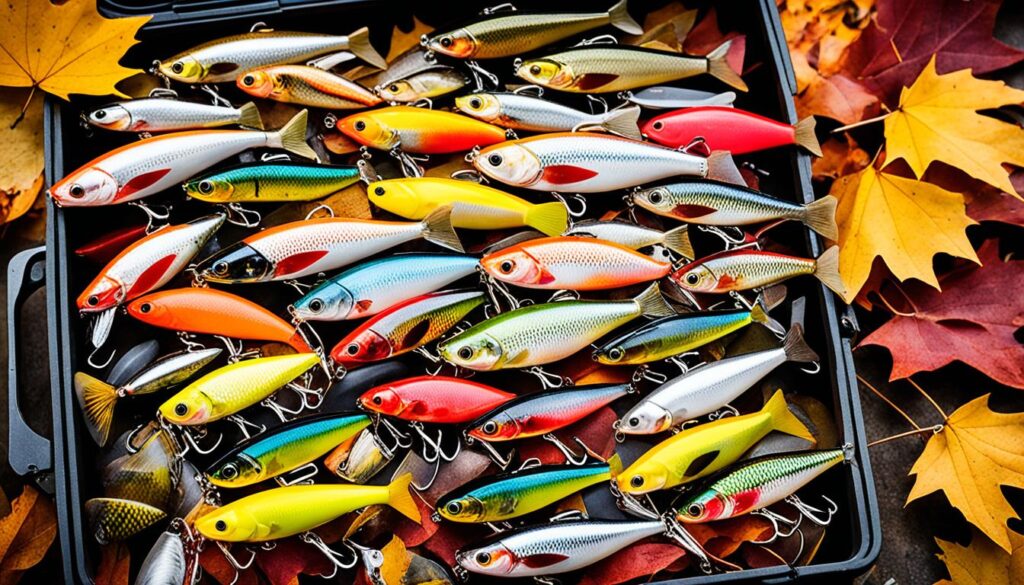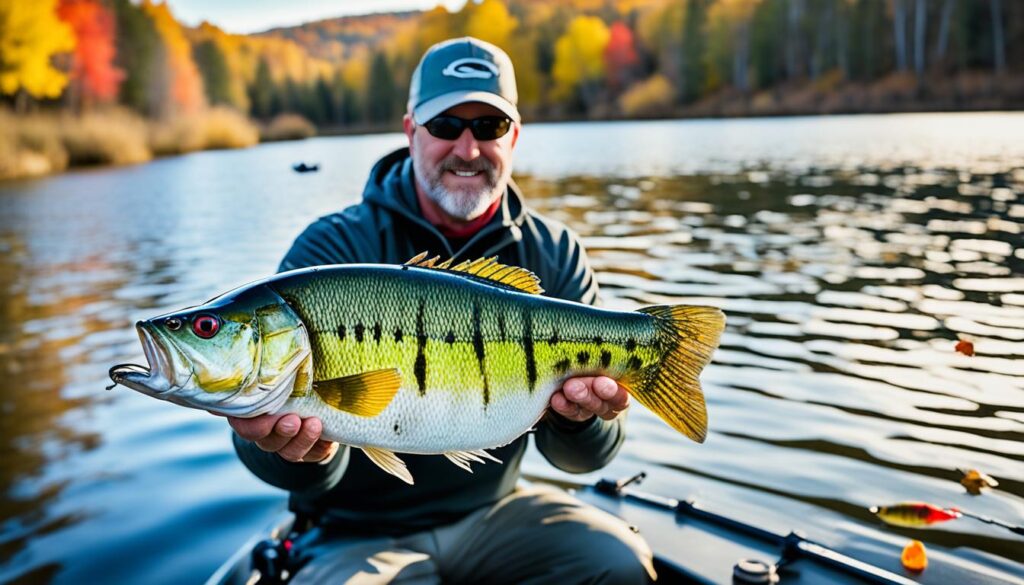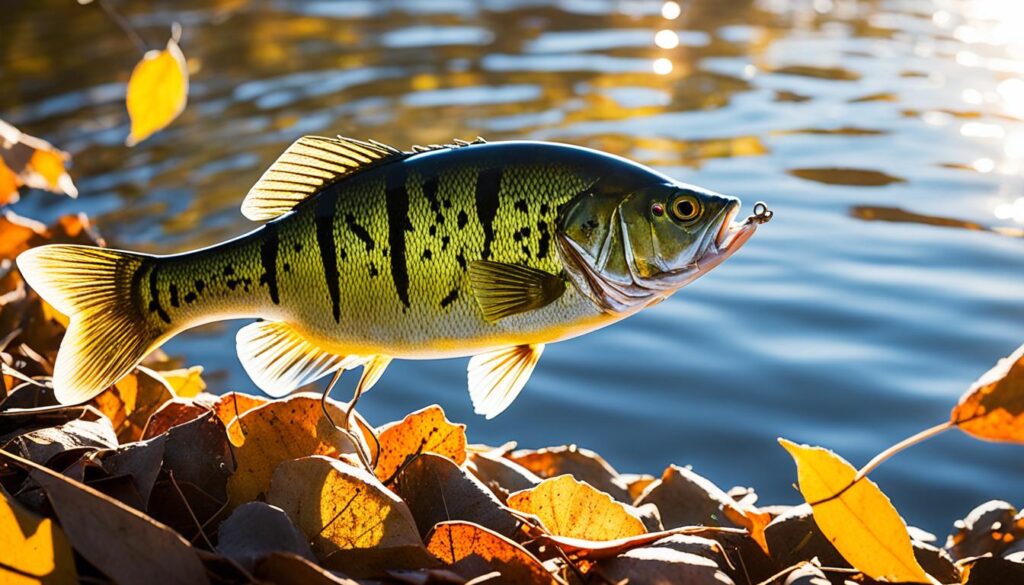Fall is an excellent time for bass fishing with lipless crankbaits. These lures can be highly effective in triggering aggressive strikes from bass during the autumn months. By using the proper techniques and gear, you can increase your chances of success. In this article, I will provide expert tips and recommendations for using lipless crankbaits to catch more bass in the fall.
Angler’s Essentials:
- Slowing down your retrieve speed can be important in colder water temperatures when bass are more lethargic.
- Squarebill crankbaits make constant contact with cover, triggering reaction strikes from bass.
- Using the right gear, such as Hardcore Crank SR 65F, Yo-Zuri T-7 Premium 100% Fluorocarbon line, and Daiwa Tatula SV TWS Casting Reel, can enhance your fishing experience.
- Varying lure colors and retrieval speeds can imitate wounded or dying baitfish, enticing bass to strike.
- Don’t be afraid to experiment with bigger crankbaits and different body styles to find what works best for fall bass fishing.
The Benefits of Using Squarebill Crankbaits in the Fall
Fall bass fishing is an exciting time for anglers, and one of the best techniques to target bass during this season is using squarebill crankbaits. These lures offer several advantages that can greatly increase your chances of success. Let’s explore the benefits of using squarebill crankbaits in the fall.
1. Slowing Down Retrieve Speed: As water temperatures rapidly decline in the fall, bass become more lethargic. The unique design of squarebill crankbaits allows you to slow down your retrieve speed, making it easier to entice sluggish bass to strike. By presenting your lure at a slower pace, you can effectively mimic the movements of injured or dying baitfish, triggering aggressive strikes from hungry bass.
2. Triggering Reaction Strikes: Squarebill crankbaits are designed to make constant contact with cover such as rocks, logs, and vegetation. This feature can be a game-changer when targeting bass in the fall. As bass seek refuge in shallow areas with plenty of cover, the ability of squarebill crankbaits to collide with and ricochet off objects can trigger reaction strikes from nearby bass. This aggressive response often leads to more hookups and an exciting fishing experience.
3. Ideal for Shallow Areas: During the fall, bass tend to move towards shallower areas, such as pockets, creeks, and ditches. These locations provide abundant cover and serve as hotspots for baitfish activity. Squarebill crankbaits are perfectly suited for fishing in these shallow areas due to their ability to navigate through obstacles without snagging. By accurately casting your squarebill crankbait into these bass-rich zones, you can maximize your chances of landing a trophy-sized bass.
Overall, squarebill crankbaits are a valuable tool in your fall bass fishing arsenal. Their ability to slow down retrieve speed, trigger reaction strikes, and effectively navigate shallow areas with cover make them an excellent choice for targeting bass during this season.
The Benefits of Using Squarebill Crankbaits in the Fall
| Benefits | Explanation |
|---|---|
| Slowing Down Retrieve Speed | Squarebill crankbaits allow you to present your lure at a slower pace, mimicking injured baitfish and enticing sluggish fall bass. |
| Triggering Reaction Strikes | The ability of squarebill crankbaits to make constant contact with cover triggers aggressive response strikes from bass. |
| Ideal for Shallow Areas | Squarebill crankbaits navigate through shallow areas with cover, making them perfect for targeting bass in these locations. |
Gear Recommendations for Fall Bass Fishing with Lipless Crankbaits
When it comes to fall bass fishing with lipless crankbaits, having the right gear is essential for success. Here are some recommendations to ensure you’re well-equipped for your fishing adventures:
| Product | Recommended Choice |
|---|---|
| Hardcore Crank SR 65F | Citrus Shad color |
| Yo-Zuri T-7 Premium 100% Fluorocarbon line | 16lb |
| Daiwa Tatula SV TWS Casting Reel | 6.3:1 gear ratio |
| Phenix X-Series Composite Crankbait Casting Rod | 7′ Heavy |
| Garmin EchoMAP Ultra 106SV Sonar | N/A |
| Garmin Panoptix LiveScope System | N/A |
| Minn Kota Ultrex Trolling Motor | N/A |
These gear recommendations cover the essentials for fall bass fishing with lipless crankbaits. The Hardcore Crank SR 65F in the Citrus Shad color is a proven bait that bass find irresistible. Pair it with Yo-Zuri T-7 Premium 100% Fluorocarbon line in 16lb for optimal performance.
For your casting reel, the Daiwa Tatula SV TWS with a 6.3:1 gear ratio offers the power and control you need. The Phenix X-Series Composite Crankbait Casting Rod in 7′ Heavy provides the right combination of sensitivity and strength for battling big bass.
When it comes to electronics, the Garmin EchoMAP Ultra 106SV Sonar and Garmin Panoptix LiveScope System offer advanced sonar capabilities that can help you locate and target bass with precision. And to navigate and control your boat, the Minn Kota Ultrex Trolling Motor is a reliable and efficient choice.
With this gear setup, you’ll be well-prepared to tackle fall bass fishing with lipless crankbaits, increasing your chances of success on the water.

Tips for Using Squarebill Crankbaits in the Fall
When fishing with lipless crankbaits in the fall, there are some key tips to keep in mind. Firstly, it’s important to slow down your retrieve speed, as bass may be more sluggish in colder water temperatures. This allows the crankbait to stay in the strike zone longer, increasing your chances of enticing a bite.
Targeting the far backs of pockets, creeks, or ditches can be effective in the fall, as these areas often have baitfish and cover that bass are attracted to. Bass tend to move into these areas to feed on the abundant forage before winter arrives. By casting your squarebill crankbait near these areas and retrieving it along the edges, you can effectively present the lure to waiting bass.
Fishing channel swing banks and shallow flat drops can also yield good results in the fall. These areas provide ideal ambush points for bass, and a well-placed squarebill crankbait can trigger a reaction strike. Cast your lure parallel to the bank and use a steady retrieve, allowing the crankbait to bounce off underwater structure and imitate a fleeing baitfish.
Additionally, using a forgiving reel and rod setup is crucial when fishing with lipless crankbaits. The forgiving action of the rod absorbs the violent headshakes that bass often make when hooked, reducing the risk of a pulled hook. Pairing your rod with a reel that has a smooth drag system ensures you can handle any aggressive runs from trophy-sized bass.
Another important consideration is using a line diameter that matches the bait’s running depth. Thicker lines create more drag in the water, causing your crankbait to run shallower. Conversely, thin lines allow the bait to dive deeper. Matching your line diameter to the running depth of your squarebill crankbait ensures you can effectively target bass at different depths in the water column.
In summary, following these tips will greatly improve your success when using lipless crankbaits for fall bass fishing. Remember to slow down your retrieve speed, target areas with baitfish and cover, use a forgiving rod and reel setup, and match your line diameter to the bait’s running depth. By implementing these techniques, you’ll be well-prepared to catch more bass during the fall season.
Changing Lure Colors and Using Speed to Trigger Bites
Fishing with lipless crankbaits in the fall requires attention to detail, and one crucial detail is changing lure colors to entice bass. The selection of the best lure color depends on water clarity and the prevalent forage in your body of water. To find what works best, I recommend experimenting with different colors until you discover the winning combination.
As you adjust lure colors, don’t forget to vary your retrieval speed to trigger bites. In colder water temperatures, slower retrieves are often more effective. However, mixing in occasional bursts of speed can imitate the erratic movements of wounded or dying baitfish, making your crankbait irresistible to bass.
<!–
| The image shows a vibrant and lifelike lipless crankbait, which is an essential tool for fall bass fishing. Use the color and speed tips to trigger more bites and increase your chances of success. |
–>
Remember, changing lure colors and adjusting retrieval speed are two valuable techniques that can significantly improve your success when fishing with lipless crankbaits in the fall. By understanding the needs and preferences of bass in different environmental conditions, you can strategically present your bait to trigger those aggressive bites. So, get ready to experiment and fine-tune your approach to maximize your fall bass fishing experience.
Using Big, Flatsided Squarebill Crankbaits in the Fall
Contrary to popular belief, using larger crankbaits in the fall can be highly effective for targeting bass. With bass feeding less frequently during this season, a big meal can be more enticing to them. Flatsided squarebill crankbaits, in particular, have a slow wobble action that bass find irresistible. Don’t be afraid to throw bigger lures and experiment with different body styles to see what works best in your fishing location.

When it comes to fall bass fishing, sometimes bigger is better. While many anglers opt for smaller lures during this season, using big, flatsided squarebill crankbaits can give you an edge. These lures have a unique action that bass find hard to resist. As they glide through the water with a slow wobble, they create a commotion that draws attention from hungry bass.
The larger size of these lures also offers an advantage in the fall. With bass feeding less frequently and searching for big meals to sustain themselves, throwing a larger crankbait can be a smart move. It presents a substantial meal that bass can’t resist, triggering their predatory instincts.
When selecting flatsided squarebill crankbaits, look for ones with vibrant colors and realistic details. These visual cues can help to attract bass in less-than-ideal water conditions, such as stained or murky water. Experiment with different body styles and colors to find the combination that works best in your fishing location.
Remember to fish these lures with a slow and steady retrieve. Allow the bait to work its magic, with its wobbling action enticing bass to strike. Pay attention to the areas with cover, such as submerged logs or weed beds, as these are prime spots for the big bass to hide and ambush their prey.
Researching Your Body of Water and Switching Up Retrieval
When it comes to using lipless crankbaits in the fall, researching your body of water is crucial. By understanding key factors such as water temperature, wind conditions, and the presence of baitfish, you can determine the best depth and pattern of crankbait to use for optimal results. Mimicking the forage in your body of water with your lure choice is also a smart strategy that can increase your chances of success.
One effective technique to consider is switching up your retrieval speed. By imitating the movements of wounded or dying baitfish, you can attract more bites from bass. Don’t be afraid to experiment with different retrieval speeds to find what works best in your fishing location.
Remember, fishing with lipless crankbaits in the fall requires a combination of knowledge and adaptability. By thoroughly researching your body of water and making strategic adjustments to your retrieval, you can maximize your chances of hooking into some quality fall bass.

Factors to Consider When Researching Your Body of Water
When researching your body of water for fall bass fishing, here are the key factors you should focus on:
- Water temperature: Bass behavior is greatly influenced by water temperature. Understanding how temperature changes in the fall can help you locate areas where bass are likely to be feeding.
- Wind conditions: Wind can impact the movement and positioning of baitfish, which in turn attracts bass. Pay attention to wind direction and intensity to pinpoint potential hotspots.
- Presence of baitfish: Baitfish are a primary food source for bass. Identifying areas with high baitfish activity can increase your chances of finding feeding bass.
Switching Up Retrieval Speed
Switching up your retrieval speed is an effective technique when using lipless crankbaits in the fall. It allows you to imitate the movements of wounded or dying baitfish, triggering predatory instincts in bass. Here are some tips for mastering this strategy:
- Start with a steady retrieve: Begin with a consistent and medium-paced retrieve to cover a large area and search for active fish.
- Vary your speed: Once you’ve established the baseline retrieve, experiment with slower and faster speeds to imitate injured prey. Mix in occasional pauses to create a more erratic action.
- Pay attention to strikes: Bass may hit the lure on the pause or during a sudden change in speed. Take note of when the most strikes occur and adjust your retrieval accordingly.
Switching up your retrieval speed is like presenting a buffet of baitfish options to hungry bass. By mastering this technique, you can entice even the most finicky fall bass to strike.
Conclusion
Fishing with lipless crankbaits in the fall can be challenging, but by following the tips and recommendations provided in this article, you can improve your chances of catching more bass. Remember to slow down your retrieve, target areas with cover and baitfish, use the right gear, and experiment with lure colors and retrieval speeds. With the right approach, you can unlock the secrets of fall bass fishing and reel in the big ones. Happy fishing!
| Tip | Description |
|---|---|
| 1 | Slow down your retrieve to match the slower behavior of bass in colder water temperatures |
| 2 | Target areas with cover and baitfish, such as the far backs of pockets, creeks, or ditches |
| 3 | Use the recommended gear, including the Hardcore Crank SR 65F, Yo-Zuri T-7 Premium 100% Fluorocarbon line, Daiwa Tatula SV TWS Casting Reel, Phenix X-Series Composite Crankbait Casting Rod, Garmin EchoMAP Ultra 106SV Sonar, Garmin Panoptix LiveScope System, and Minn Kota Ultrex Trolling Motor |
| 4 | Experiment with different lure colors to find what works best in your body of water |
| 5 | Vary your retrieval speed to imitate the movements of wounded or dying baitfish |
In conclusion, fall is an ideal time to target bass using lipless crankbaits. These versatile lures can effectively trigger aggressive strikes, especially when paired with the right techniques and gear. By following the expert tips and recommendations provided in this article, you’ll be well-equipped to catch more bass during the fall season.
Remember to slow down your retrieve speed and target areas with cover and baitfish, as bass tend to be more lethargic in colder water temperatures. Use the recommended gear, including the Hardcore Crank SR 65F and the Daiwa Tatula SV TWS Casting Reel, to enhance your chances of success. Experiment with different lure colors and retrieval speeds to imitate wounded or dying baitfish, enticing bass to strike.
So grab your lipless crankbaits, gear up with the right equipment, and get ready for an exciting fall fishing season. With these lipless crankbait tips for fall bass, you’ll be well on your way to reeling in those trophy-sized catches. Happy fishing!
FAQ
What makes squarebill crankbaits effective in the fall?
Squarebill crankbaits are effective in the fall because they allow you to slow down your retrieve speed and make constant contact with cover, triggering reaction strikes from bass.
What gear do you recommend for fall bass fishing with lipless crankbaits?
For fall bass fishing with lipless crankbaits, we recommend the Hardcore Crank SR 65F in Citrus Shad color, Yo-Zuri T-7 Premium 100% Fluorocarbon line in 16lb, Daiwa Tatula SV TWS Casting Reel with a 6.3:1 gear ratio, Phenix X-Series Composite Crankbait Casting Rod in 7′ Heavy, Garmin EchoMAP Ultra 106SV Sonar, Garmin Panoptix LiveScope System, and Minn Kota Ultrex Trolling Motor.
What tips can you offer for using squarebill crankbaits in the fall?
When using squarebill crankbaits in the fall, it’s important to slow down your retrieve speed, target areas with cover and baitfish, use a forgiving reel and rod setup, match your line diameter to the bait’s running depth, and experiment with lure colors and retrieval speeds.
How can I change lure colors to trigger bites with lipless crankbaits in the fall?
Changing lure colors can be crucial when fishing with lipless crankbaits in the fall. The best color choice depends on water clarity and the predominant forage in your body of water. Experimenting with different colors can help you find what works best.
Are bigger crankbaits effective for targeting bass in the fall?
Yes, using larger crankbaits in the fall can be highly effective for targeting bass. With bass feeding less frequently during this season, a bigger meal can be more enticing to them. Flatsided squarebill crankbaits, in particular, have a slow wobble action that bass find irresistible.
How important is researching your body of water when using lipless crankbaits in the fall?
Researching your body of water is essential when using lipless crankbaits in the fall. Factors such as water temperature, wind conditions, and the presence of baitfish can help you determine the best depth and pattern of crankbait to use. Mimicking the forage in your body of water with your lure choice can also increase your chances of success.
What can I do to increase my chances of success when fishing with lipless crankbaits in the fall?
To increase your chances of success when fishing with lipless crankbaits in the fall, it’s important to slow down your retrieve, target areas with cover and baitfish, use the recommended gear, experiment with lure colors and retrieval speeds, and research your body of water to determine the best approach.
